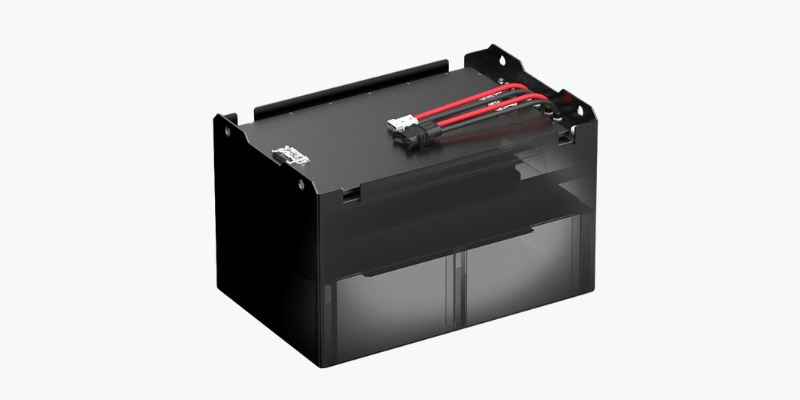يعد اختيار البطارية الصناعية المناسبة أمرًا حيويًا لتحقيق الكفاءة عند استخدام الرافعات الشوكية، سواء لشاحنة واحدة أو لأسطول. يمكن لبطارية الرافعة الشوكية الكهربائية المناسبة توفير الوقت والمال على المدى الطويل.
في هذه المقالة، سنغطي بطاريات الرافعات الشوكية المختلفة والاختلافات الرئيسية بينها ونطاقات الأسعار.
أنواع بطاريات الرافعات الشوكية
في حين أن البروبان والديزل والغاز هي خيارات أخرى، فإن ثلثي الرافعات الشوكية التي يتم وضعها في الخدمة كل عام هي كهربائية.
يتم تشغيل الرافعات الشوكية الكهربائية بشكل أساسي بواسطة نوعين من البطاريات: حمض الرصاص والليثيوم أيون.
يؤثر نوع البطارية على تردد الاستبدال: يمكن لبطاريات الليثيوم أيون أن تدعم أكثر من 3000 دورة، بينما تدوم بطاريات الرصاص الحمضية حوالي 1500 دورة. بالإضافة إلى ذلك، تتطلب بطاريات الليثيوم أيون استبدالًا أقل تكرارًا، مما يجعلها مفضلة على بطاريات الرصاص الحمضية للعديد من أصحاب الأعمال.
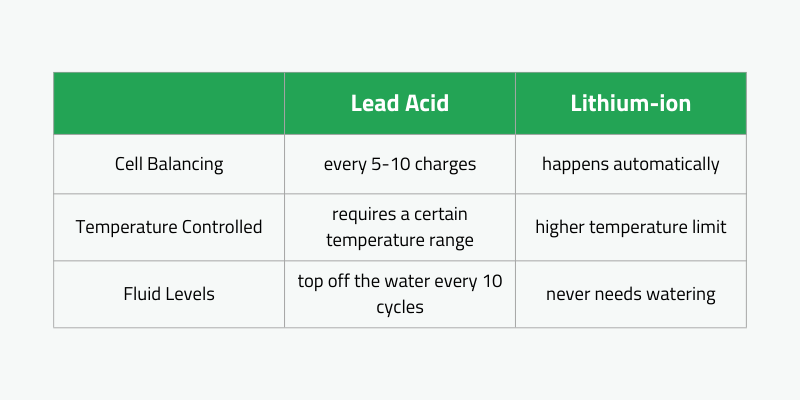
الفولتية بطارية رافعة شوكية
عادةً ما يتم اختيار مجموعات بطاريات الرافعة الشوكية بناءً على معدات الرفع والاستخدام المقصود لها. هناك أربعة خيارات الجهد المشتركة:
- 24 فولت: مناسب لمعدات الرفع الكهربائية الصغيرة مثل الراكبين النهائيين، والراكبين المركزيين، وأجهزة الرفع اللاسلكية، ورافعات البليت اللاسلكية.
- 36 فولت: مصمم للمعدات الكهربائية متوسطة الحجم مثل الرافعات الشوكية ذات الممرات الضيقة والرافعات الشوكية المتوازنة.
- 48 فولت: يستخدم للمعدات الكهربائية الكبيرة بما في ذلك الرافعات الشوكية المتوازنة.
- 80 فولت: مخصص للمعدات الكهربائية الثقيلة مثل الرافعات الشوكية الكبيرة المتوازنة.
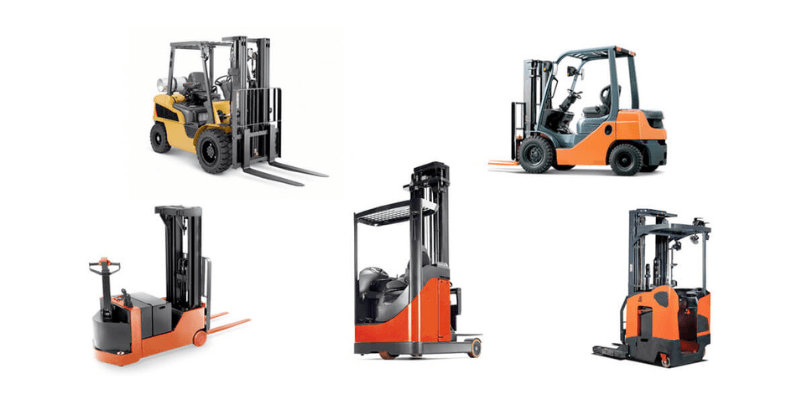
شحن بطارية الرافعة الشوكية
تؤثر الطريقة التي يتم بها إعادة شحن بطارية شاحنة الرفع الكهربائية على الكفاءة التشغيلية واحتياجات محطة الشحن.
يتم شحن بطاريات الليثيوم أيون بشكل أسرع ويمكن شحنها بشكل مناسب دون الحاجة إلى إعادة شحنها بالكامل. وفي المقابل، يجب أن تكون بطاريات الرصاص الحمضية مشحونة بالكامل قبل فصلها ولا يمكن شحنها بشكل انتهازي.
يتدهور كلا النوعين إذا تم شحنهما بشكل غير صحيح، لكن وحدات حمض الرصاص لديها إرشادات أكثر صرامة.
متطلبات محطة شحن بطارية الرافعة الشوكية
يعد موقع نظام شحن بطارية الرافعة الشوكية أمرًا بالغ الأهمية.
تتطلب بطاريات الرصاص الحمضية إعدادات محددة لا تتطلبها عبوات الليثيوم أيون. يمكن شحن بطاريات الليثيوم أيون مباشرة أثناء وجودها في شاحنة الرفع، دون الحاجة إلى خطوات إضافية.
يجب إزالة بطاريات الرصاص الحمضية لشحنها على أجهزة شحن منفصلة قادرة على معادلة الشحنة. تحتاج الشركات التي لديها العديد من الرافعات الشوكية إلى أجهزة شحن متعددة ومساحة لتبريد الوحدات بعد إعادة الشحن. تستغرق هذه العملية وقتًا طويلاً، حيث يحتاج الموظفون إلى معدات خاصة لإدارة عمليات تبديل البطارية بانتظام.
بالإضافة إلى ذلك، تحتاج مناطق شحن الرصاص الحمضية إلى تهوية مناسبة بسبب الحرارة والأبخرة الضارة التي تنتج أثناء الشحن. وعلى العكس من ذلك، يمكن شحن بطاريات الليثيوم أيون مباشرة في شاحنة الرفع دون الحاجة إلى مساحة مخصصة أو فترات تبريد. يمكنهم إعادة الشحن فورًا في الموقع عند تفريغهم.

نظام سقي بطارية الرافعة الشوكية
الشحن ليس هو الصيانة الوحيدة المطلوبة لبطاريات الرصاص الحمضية؛ يحتاج سائلهم إلى اهتمام منتظم.
على عكس بطاريات الليثيوم أيون المغلقة، تتطلب بطاريات الرصاص الحمضية نظام سقي. يجب أن يتعلم الموظفون كيفية ري هذه البطاريات بشكل صحيح لضمان الأداء الأمثل وطول العمر.
تشمل الممارسات الأساسية للحفاظ على سقي بطارية الرافعة الشوكية الحمضية الرصاص ما يلي:
- تتصدر بالماء فقط بعد الشحن الكامل والتبريد.
- قم بإعادة التعبئة بانتظام للحفاظ على الجزء العلوي من اللوحات مغطى، عادة كل 10 دورات شحن.
- تجنب الإفراط في التعبئة للسماح بتمدد السائل أثناء الاستخدام.
- استخدام الماء ذو الرقم الهيدروجيني بين 5 و7.

سلامة بطارية الرافعة الشوكية
تعد السلامة أمرًا بالغ الأهمية عند التعامل مع بطاريات الرافعة الشوكية نظرًا للمواد الكيميائية القوية الموجودة فيها. دعونا نقارن بطاريات الليثيوم أيون وبطاريات الرصاص الحمضية من حيث السلامة في مكان العمل.
مخاطر سلامة بطارية الرصاص الحمضية هي كما يلي:
1. الانسكابات: يمكن أن ينسكب حمض الكبريتيك من هذه البطاريات، خاصة أنها تتطلب سقاية أسبوعية. يؤدي التعامل غير السليم إلى زيادة مخاطر الموظفين، مما يستلزم محطة غسيل كيميائي.
2. ارتفاع درجة الحرارة: يمكن أن تصبح هذه البطاريات ساخنة للغاية أثناء الشحن وقد تتسرب غازات متفجرة بعد ذروة الشحن، مما يجعل التحكم في درجة الحرارة ضروريًا للسلامة.
3. الغازات الخطرة: يمكن أن يؤدي الشحن الزائد إلى إطلاق غازات سامة مثل كبريتيد الهيدروجين والهيدروجين وثاني أكسيد الكبريت في مناطق سيئة التهوية. تشير رائحة البيض الفاسد إلى وجود كبريتيد الهيدروجين؛ وينبغي اتخاذ الاحتياطات الفورية. قم بتركيب أجهزة استشعار الغاز الحفزية القياسية LEL أو أجهزة الاستشعار الكهروكيميائية في غرف الشحن لمراقبة مستويات الغاز.
4. البطاريات القديمة أو المتآكلة: في حين أن بطاريات الرصاص الحمضية الجديدة تشكل خطرًا ضئيلًا إذا تم شحنها بشكل صحيح، فإن البطاريات القديمة أو المتآكلة تشكل خطرًا ويجب التخلص منها على الفور.
على العكس من ذلك، فإن بطاريات الليثيوم أيون للرافعة الشوكية محكمة الغلق، مما يمنع مخاطر انسكابات الأحماض أو التآكل.
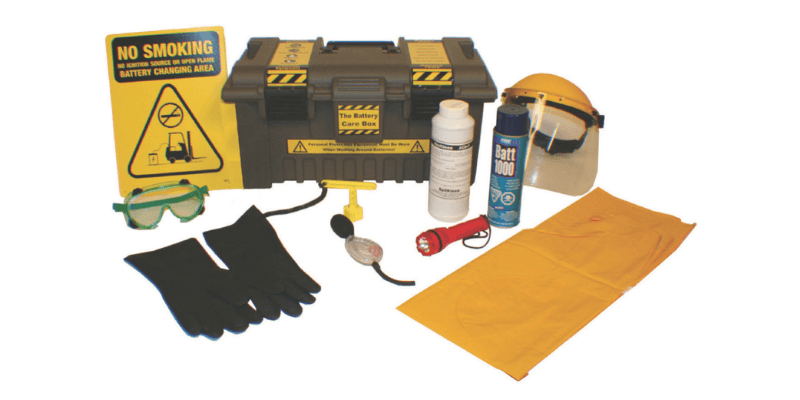
تسعير بطارية الرافعة الشوكية
تختلف تكاليف بطارية الرافعة الشوكية بشكل كبير حسب النوع. وتتراوح تكلفة بطارية الرصاص الحمضية من 2000 دولار إلى 6000 دولار، بينما تتكلف بطارية الليثيوم ما بين 17000 دولار و20000 دولار.
ومع ذلك، فإن هذه الأسعار لا تعكس التكلفة الإجمالية للملكية (TCO). يجب على المديرين النظر في النفقات طويلة الأجل المرتبطة بكل نوع قبل اتخاذ القرار.
في عمليات المستودعات، تعتبر العمالة هي التكلفة الأكبر، مقاسة بالوقت. سيؤدي شراء بطاريات الرصاص الحمضية إلى زيادة تكاليف الرافعة الشوكية الإجمالية لأنها تتطلب ساعات عمل طويلة للتشغيل السليم. تدوم كل بطارية حوالي 8 ساعات وتحتاج إلى 16 ساعة للشحن والتبريد، مما يستلزم ثلاث بطاريات على الأقل لكل رافعة شوكية للعمليات على مدار الساعة طوال أيام الأسبوع. هناك حاجة أيضًا إلى بطاريات إضافية للصيانة، مما يؤدي إلى المزيد من الأعمال الورقية وفريق متخصص للتتبع.
بطاريات الرصاص الحمضية كبيرة وتتطلب مساحة تخزين مخصصة تتوافق مع إرشادات المركز الكندي للصحة والسلامة المهنية، مما يؤدي إلى تكبد تكاليف إضافية. ومن الضروري وجود معدات متخصصة لمراقبة هذه البطاريات.
علاوة على ذلك، هناك مخاطر مهنية بسبب سوائلها المسببة للتآكل؛ يمكن أن تؤدي الانسكابات إلى إيقاف العمليات وتكبد المزيد من تكاليف الوقت.
على الرغم من أن التكاليف الأولية للبطاريات منخفضة، إلا أنها لا تدوم سوى حوالي 1500 دورة مع الصيانة المناسبة، مما يتطلب استبدالها كل 2-3 سنوات إلى جانب تكاليف التخلص من الوحدات القديمة.
من ناحية أخرى، تعد بطارية الرافعة الشوكية الليثيوم أيون أخف بنسبة 55٪ من بطاريات الرصاص الحمضية وتوفر فوائد مثل تقليل متطلبات المساحة، والشحن الأسرع، وكفاءة الطاقة الأعلى، وتحسين سلامة العمال، وتحسين الأداء البارد، وزيادة الإنتاجية.
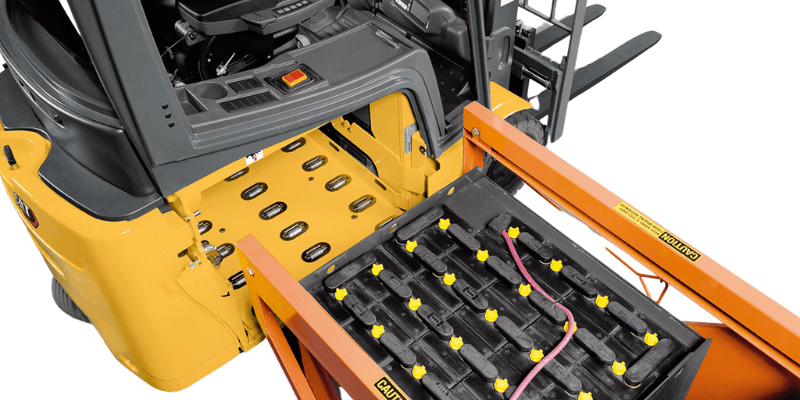
خاتمة
توفر بطاريات الليثيوم أيون، على الرغم من ارتفاع سعرها في البداية، وفورات طويلة الأجل من خلال الكفاءة وانخفاض الصيانة. إن الشحن السريع والمتانة والسلامة يجعلها مثالية للرافعات الشوكية.
عند الاختيار بين حمض الرصاص وأيونات الليثيوم، ضع في اعتبارك تردد الاستخدام واحتياجات السلامة. يعمل الاستثمار الذكي في البطارية على تعزيز الإنتاجية وتقليل وقت التوقف عن العمل، مما يساعد شركتك على الحفاظ على قدرتها التنافسية في سوق الرافعات الشوكية الكهربائية.

